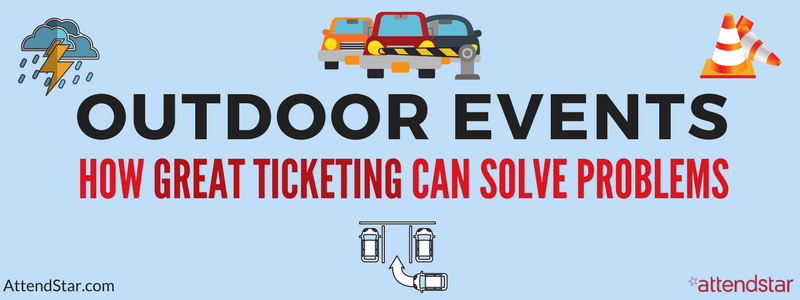
Outdoor events create some very unique problems, and many of those problems are passed on to ticket buyers. The result? Fewer tickets are sold. To ensure your outdoor event is successful and profitable, you need to understand two important things:
- Outdoor events are usually held at places that were not designed to be event venues.
- Outdoor events are often held in the parking lots of indoor event venues where people normally park.
What do these two things have in common? I’ll tell you. Outdoor events are often held at venues that invite traffic problems. In fact, a large outdoor event association conducts an annual survey, and year after year, the top complaint by ticket buyers has been traffic and the lack of organization related to that traffic.
So you have one big problem when it comes to planning and holding an outdoor event – traffic (and the effect of weather conditions on traffic). However, there are many underlying problems that cause your traffic problem to grow bigger and bigger. Fortunately, a great ticketing software company can help you solve many of these problems.
In order, let’s take a look at some of the biggest problems that exacerbate the traffic problem for outdoor events and see how a great ticketing company can solve them with you.
1. Your Phone System
It’s likely that you have one or two lines for your office phone system, which is probably all you need – except when it’s the week of your event. Phone calls will skyrocket in the days leading up to your event, and those one or two lines won’t be enough.
AttendStar has done several studies and tracked call volume for outdoor events from 15,000 to 60,000 people under various weather conditions. We’ve seen a consistent call volume pattern for outdoor events:
- 8 Days Before Event = 60 to 100 calls
- 7 Days Before Event = 80 to 120 calls
- 6 Days Before Event = 130 to 140 calls
- 5 Days Before Event = 150 to 200 calls
- 4 Days Before Event = 200 to 300 calls
- 3 Days Before Event = 300 to 400 calls
- 2 Days Before Event = 400 to 700 calls
- 1 Day Before Event = 700 to 3,000 calls
You can see the data visually in the charts below.
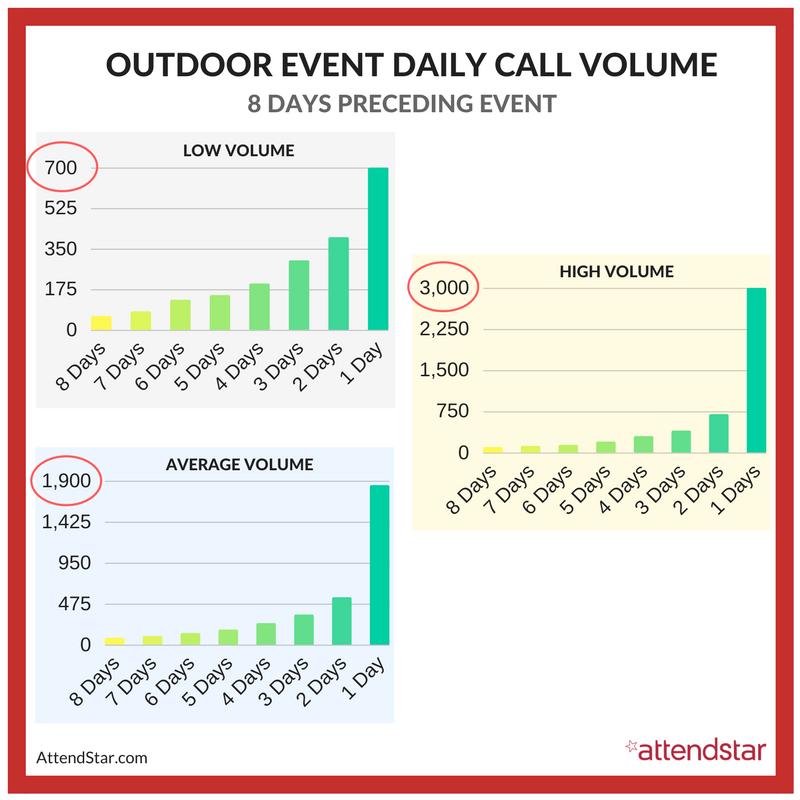
Look at that call volume! In the data pulled from actual outdoor events ticketed through AttendStar’s ticketing software, a weather forecast calling for no rain would get 900 calls, but with rain in the forecast, the call volume can jump significantly – up to 3,000 calls for one event!
But that’s not all. Guess when those calls come in? Four out of five calls (80%) come between 10:00 a.m. and 4:00 p.m. Clearly, your small team handling calls from one or two phone lines will not be able to keep up with the volume. Calls will be missed, and your team will be tied to their desks when they should be out setting up the event!
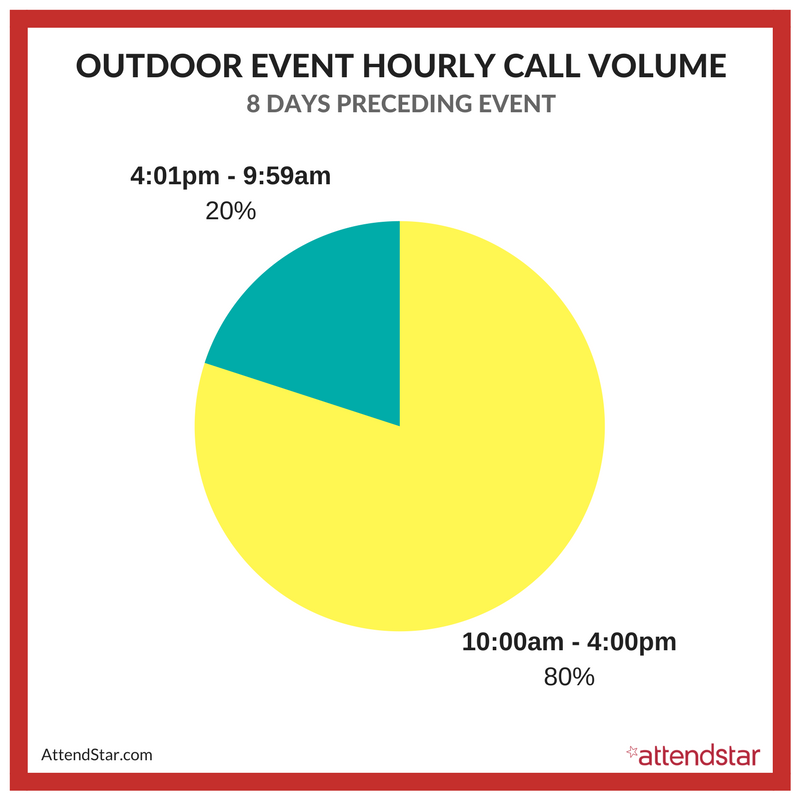
AttendStar solves this problem by creating a unique phone number and phone tree for each event. The phone tree can be programmed to call certain numbers for vendors, sponsors, and so on. You can use it to provide information on how to get to the event and what to expect. To get an idea of how this works, here is the number to an air show we ticketed in Memphis, Tennessee: 901-466-8434. Feel free to call, push all the buttons, and see what we did.
Providing a phone tree reduced the number of people we had to speak with on the phone by 60% to 75%, so the savings to the event are huge! Your phone system should have the ability to update your phone tree without contacting your provider, and ideally, you should be able to change the greetings as needed in real time.
2. Traffic Flow
Everyone hates traffic. In fact, keeping the traffic flow moving is the worst issue for large outdoor events. You’ll sell fewer tickets if people think the traffic will be too problematic to bother attending, and people who do buy tickets but spend an inordinate amount of time stuck in traffic are likely to complain about it with friends and on social media. That could lead to fewer ticket sales the next time you hold the same or a similar event.
A key to solving the traffic flow problem is knowing where your attendees will come from and having a way to reach them instantly when traffic routes should be altered. Providing this type of information could be a real winner for your event. You might not be able to solve all of the problems attendees will face, but the fact that you recognized the issues and tried to solve them will go a long way with your attendees.
At AttendStar, we solve the traffic flow problem by asking for the zip code and cell phone number for each ticket buyer. We then plot those zip codes on a map and create what we call quadrants. Next, we look at where the parking for the event is located and how many cars can park in each lot. We arrange the quadrants so the cars fit, and we email the attendees several times letting them know the best route to take to the appropriate parking lots. We’re also sure to tell attendees not to use their GPS since entrances to large outdoor events are rarely located at the street address people can find on the internet.
In addition, we text attendees about traffic and weather issues they might need to know about. Since we know which attendees are coming from which direction, we don’t need to text all of them – just the people coming from the specific quadrant that is affected by the traffic issue. Texting is also the best way to reach people when there is a rain delay or other important last-minute information.
AttendStar also works with local law enforcement to advise them of where people are coming from so they can erect signs and so on. This communication enables local traffic management to let AttendStar know what the throughput is of major roads. In other words, a great ticketing company acts as the go-between, so your attendees can get to your event.
3. Entrance Gates
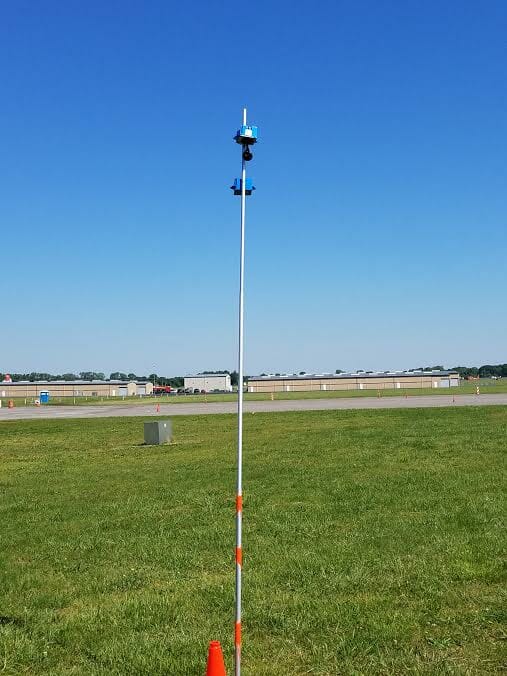
If you have a drive-in gate vs. a walk-in gate, your throughput per hour can be very different. This is really important when calculating how many scanners or credit card machines you need. Furthermore, making sure you communicated in advance about what attendees are NOT allowed to bring into the event is critical if cars are parked a long distance from where security is located.
For example, if you have a walk-in gate, you’ll need six lanes, but for an event with a drive-in gate, you’ll need 12-16 lanes. A drive-in gate will result in fewer people watching an event from their cars, but also will require more people and more volunteer training to handle the moving cars. You’ll also need traffic vests and hundreds of traffic cones, which should be bright and easy to see in order to effectively guide cars. The cones should be placed no more than six feet apart or cars will try to cut through to other traffic lanes.
For every two lanes, you need two traffic direction people. This is essential because if you can’t get the cars into all 12 lanes, your two middle lanes will get all the traffic causing a traffic nightmare! You also need 600 feet of space between the 12 lanes and the place where the cars first come onto the grounds.
Many event organizers underestimate the complexity of how to park cars efficiently. In fact, most of our large outdoor events hire a professional traffic and parking company. After all, this is the first impression your attendees have of your event, so you need to get it right!
If your event is checking bags and purses that people bring with them, you need at least two times as many bag inspection stations as you need ticket-takers and sellers. If you’re checking for guns and knives, you should hire professionals with high speed wands that can keep the lines moving.
In addition, if you’re putting wristbands on ticketholders, you need two times as many of those people, and you shouldn’t let the same people who scan or sell tickets also put wristbands on attendees. Keep in mind, selling and scanning tickets is much faster than security or people putting on wristbands.
At events ticketed by AttendStar, we have cameras that we place at the various entrance points (see the picture above). We send the video to a web page that event organizers and law enforcement can see. We also send the video back to our Event Operations Center in Nashville where we have someone watching the video and in touch with the event and local law enforcement. This is so important because the team on the ground at the event is often extremely busy and can easily miss key items that require immediate attention.
4. Internet
If you need to be able to access the internet at the gates, then you need to understand that you won’t get the same coverage as you do inside an indoor venue. You’ll need about one portable internet device for every 40 feet of outdoor space. Right before your event is set to start, more people will be on their phones trying to meet up with family and friends. No matter how fancy or sophisticated your technology is, there are two main problems that can happen if you don’t have enough portable internet devices:
- The local phone 4G network gets overloaded and connections start to drop.
- If you’re using a single carrier like Verizon for your connection, then you lose all connectivity and there’s nothing you can do.
With that said, you need to plan ahead. If you’re scanning tickets, you have two choices:
- Use a ticketing system that works in “offline mode” in addition to online mode.
- Make sure you have modems from more than one provider up and running at all times.
Remember, anything and everything can go wrong with complicated internet and scanning technologies, so don’t wait until 10 minutes before the gates open to test everything. Do this the day before the event, and do it again one hour before the event starts. Count on it not working at first.
5. The Gate Team
Large outdoor events sometimes have team members working far away from food and water. Don’t forget them! Provide plenty of water and encourage them to drink it. We’ve seen teams get dehydrated and sick because they didn’t have access to water at more outdoor events than you would think!
Next, safety vests are very important when team members are around cars. You can find them at Home Depot and Lowes. This is so important for obvious safety reasons, and don’t forget this could be a legal liability issue for your event as well.
6. Exit Plans
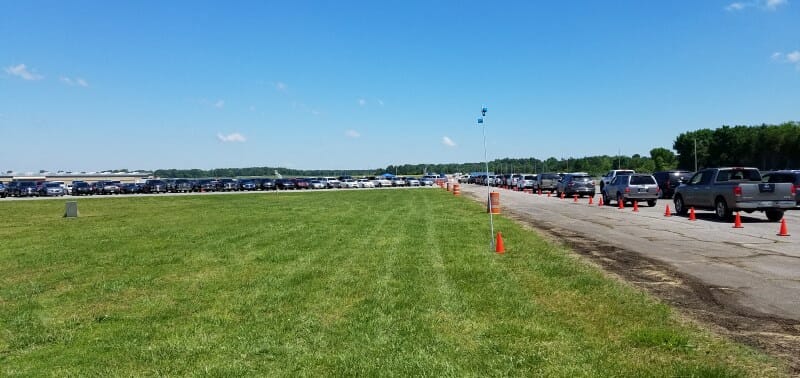
About one hour before the end of the event, your gate manager needs to move the traffic cones and “turn the gate around” to ensure attendees can exit efficiently. You’ll need to take all of your lanes and move them into two lanes (if you have two lanes). Remember, you might allow guests to arrive over a two to four hour period, but when the event is over, it’s all at once, especially if there is a headline act that performs last.
Also, if it’s hot and the walk from the event to the parking lot is long, you should have people in golf carts with water and radios to medical staff. Think of it this way. If the event is charging $4 for a bottle of water, many people will avoid buying it. They’ll tend to get dehydrated and try to make it to their cars without drinking in an effort to save money. Ultimately, they might need assistance getting to their cars.
While I’m on the subject, make sure you have a plan for ambulance traffic to exit your venue from not only the main event area but from the parking lots as well. Your local team, your local on-the-ground AttendStar team, and the AttendStar Event Operations Center in Nashville are always watching for emergencies and are in direct contact with emergency services, but monitoring is useless if emergency vehicles cannot get through. The photo above shows cones set up for emergency vehicles at an event ticketed by AttendStar where our on-the-ground team snapped this picture.
You might be tempted to cut expenses and let the traffic just exit on its own, but when your guests are sitting for 30 minutes waiting to leave and no one is there trying to help them, that just looks bad. Ultimately, your event and the venue could get negative word-of-mouth marketing, which means you’ll sell fewer tickets to similar outdoor events in the future.
Even When It’s Over, It’s Not Over
The event is over and the traffic has cleared, but it’s not over for you yet. Now, it’s time to send an email and thank your guests. You should also survey them to see what they liked and what they didn’t like. You can do all of this through the AttendStar ticketing software.
For your team, it’s time to have a “survivor party” where you thank everyone and ask them to share things they saw that need to be improved for the next event. Don’t skip this important task!
As you can see, ticketing might not be your biggest outdoor event problem, but the right ticketing company can help solve many of the problems you face as an event organizer. If you have any tips to share, we’d love to hear them in the comments section below. You can also contact Gary Bradshaw at AttendStar (615-223-1973) or use the Contact Us Form.
Save
Save


